Friday, 17 December 2010
Feedback after first shoot
Thursday, 2 December 2010
Production Evaluation (Cinematography)
As soon as I took on the role of cinematographer, I realised that my main responsibilities would fall during the shooting of the film, and that has certainly been the case. I have tried to take the lead throughout the filming of our scenes, and have done this through several key aspects.
Firstly, I have assessed each location at which we have filmed, ensuring that the mise-en-scene is fitting for our genre, as well as for the ideal scenes that we wanted to shoot. Furthermore, I had to work in conjunction with the editor to check that every shot would allow for good continuity when used in the editing suite, making sure that all costumes, lighting and props stay constant throughout. Keeping the length of each shot long enough meant that the editor would also find it easier to cut each part and fit it with others; we understood completely that shooting more shots than were needed would mean we would NOT have to reshoot at another time.
Personally, one of my favourite aspects of being the cinematographer is shooting aesthetically pleasing shots with good composition, thus making the film look professionally done. For this reason, I spent lots of time before shooting each single shot to ensure that no shots were of a poor quality. Using the 'rule of thirds' (helped by a nine square grid which I activated on the camera screen), I was able to shoot each shot with good composition, making sure there was little room above the head, and not a lot of empty space at the sides of shots. This also helps in the editing suite.
One scene I am pleased with is the scene in which our protagonist arrives home and enters the kitchen, oblivious to the fact that the fridge door is opening behind her. I managed to shoot lots of shots from various angles (adhering to the 180 degree rule) throughout the scene, using panning to add effect. Furthermore, after shooting several shots, we assessed the lighting and after deciding it was too bright on the girl's face, we changed the angles of the lights, allowing a softer light to fall onto the setting. Finally, we shot an over the shoulder shot to finish the scene, which is something we were very pleased with.
Overall, the scenes that we have managed to shoot so far look quite professional, and due to the fact that we have shot so many this will allow us a lot to use in the editing suite. However, I am most pleased with the composition and continuity of the shots, as we have used a range of shot types and angles whilst still ensuring that it is aesthetically pleasing and fitting for the horror genre. We do understand that there are some sections which may need reshooting, such as in the mother's bedroom, but our grasp on aspects such as lighting and mise-en-scene has improved throughout production, and this will definitely help when we shoot our final scene at the graveyard, and then continue to edit 'Home Video'.
Josh Murray- Incentive
Wednesday, 1 December 2010
Production evaluation
As role of editor it was vital for me to play a significant part in the shooting of our horror film. This is because it was important for me to see which shots worked very well on the day and which did not. At the start of each scene I was able to say on camera if the shot before was relevant and what I did or didn’t like about it, making it a lot easier when it comes down to the final editing.
Also, I liaised with the director, cinematographer and the sound designer to tell them which shots I thought would work for good continuity and composition. I asked the cinematographer if he could shoot the scenes in long parts so that when it comes to the editing I can make shots shorter where needed to make good continuity. If the shots weren’t long enough, it would have made it a nightmare. I would have had to have put several short shots together to make a longer scene. The camera could’ve been in different places and the composition may not be the same throughout if it was shot in smaller shots. I also gave advice to the director as to where the camera had to be put in order to maintain good continuity throughout the final film. And, because I already have an idea as to what the final film should look like, due to the fact that I have to edit it, I advised the director about certain shots which I thought would add the most horror affect to the final film, and would show the characteristics of a psychological horror.
To make the final sequence look perfect it was vital for me to make sure that the pace and length of each shot was adequate and fitted the scene. A shot that looked out of place, or which was shot too slow or too long had to be removed or noted down whether the shot was good or not. If the run up to our final shot was too fast, it may not have delivered the right amount of tension, because a slow shot creates fear and a sense of unknown for the audience. Also, during the kitchen scene, if the victim shut the fridge door slowly, it wouldn’t have had an as big effect as if she closed it fast. When the pace of a shot is fast, it gets the audience panicking and increases the nerves, furthermore, it foreshadows that something is going to happen towards the end of the sequence.
Finally, I made it clear to the director/cinematographer that I would like the shots to be shot in order according to the storyboard. This makes it easier to follow when it comes to editing the shots. A disorganized sequence of shots can take lots more time to edit and could cause confusion about which shot goes where.
Sam Van de Schootbrugge- Incentive
Friday, 19 November 2010
Scheduling
Wednesday, 17 November 2010
Garageband First Attempt

Tuesday, 16 November 2010
Pre-Production Evaluation (Cinematography)
In the creation of any film there are many roles which all need to be fulfilled to ensure that the film is planned, shot, edited and completed to the best possible quality. This was no different with our horror opening, although the fact that our group includes just two people meant that we realised we would have to share many jobs between us. However, we both decided on a role which we would focus on throughout the process, and I chose to be the cinematographer.
My role will be a very important one if we are to make a top quality film, and will require me to play a massive part throughout the entire shooting process.
Firstly, I will be responsible for maintaining that each setting is correct, and that all the props are positioned effectively to create the right atmosphere and mise-en-scene for our genre: in the case of 'Home Video', I will have to ensure that generic conventions such as shadows are upheld, and that effective props such as the televisions are working prior to shooting. Our aim is of course to create the best possible film, and a massive aspect of this is continuity. Although this aspect will be examined and adjusted in the editing suite, it is the job of the cinematographer to guarantee that each shot (from different angles and positions) will not reveal differing situations.
Possibly the most prominent role for me in our task will be the actual filming. Our film must be between 4 and 5 minutes in length, and after writing our script, step outline and written storyboard we managed to decide on 78 shots that would be needed. It will be my job to position everything in the scene (the actors, props and lighting) as well as the camera itself, and then shoot the scene; this could mean I just stand there and watch over the action, or use the camera if tracking, panning or zooming is needed. As I wish for our film to look professional, I will take it upon myself to reshoot any shot which looks poor or are not completed in the way that we envisaged.
However, although we have decided on a definite amount of shots, this is going to be flexible, and I believe that we will shoot over 100 shots to create a lot of items to be used by the editor. These decisions will again lie with me, and I will confer with Sam when making changes or additions to shots throughout the film.
The relationship between the cinematographer and the editor is vital, and Sam and I will make sure that we always talk through the shots that I am going to take, as it will be he who has to work with the shots in the editing suite.
An important resource that we have used throughout our planning process has been the various films that relate to our sub-genre of psychological horror. The ones that inspired me most as a cinematographer were 'The Grudge' and 'The Ring', as both use camera angles and mise-en-scene to enhance the tension and fear which is already evident through the setting. Firstly, the use of televisions as a tool for the supernatural in 'The Ring' is something that we are very keen on using, and I have already planned several canted angle shots of the television which will create a sense of confusion in the first and final scene. Furthermore, there is several high angle shots in both films (especially on the stairs) that show the position of weakness and loneliness that the protagonist finds themselves in; this is something I plan to shoot as our female character ascends the stairs cautiously. Finally, the way that the film openings are shot allow the viewer to understand that something 'supernatural' is going on, whilst keeping the narrative restricted, as we are never certain of what is occuring. This is something I will concentrate on in the final scene, when the character begins to feel uncomfortable.
Overall, my role as cinematographer will mean that I must take a constant interest in the entire shooting process; ensuring that the scene is perfect BEFORE the camera begins to roll, at which point I will stand behind the camera and shoot the entire scene. Although it is a lot of work, I feel that the role will be both enjoyable and rewarding, and I can learn a lot about the processes as I go along.
Friday, 12 November 2010
Sound Step Outline

 These sheets link with the previously completed step outline, adding the important element of sound. Using this exercise, we have planned all of the major diegetic and non-diegetic sounds which will be heard in each scene of our film. Almost all of the sounds will be relevant, with very little contrapuntal; this is visible in what we have written.
These sheets link with the previously completed step outline, adding the important element of sound. Using this exercise, we have planned all of the major diegetic and non-diegetic sounds which will be heard in each scene of our film. Almost all of the sounds will be relevant, with very little contrapuntal; this is visible in what we have written.
Pre-Production Evaluation (Editing)
Editor- Sam Van de Schootbrugge
In order to produce the best possible film we needed to designate certain roles within our group. I chose to focus on the editing.
My role as editor is important for an excellent film. I get given the several hours worth of shots and filming, and must decide which of them look best. My job is to deliver good Composition and Continuity throughout the final 5 minute assessed piece so that the film can be scary for all the right reasons. Bad editing can lead to the audience becoming bored, the film not being scary where we want it to be and it could deliver the wrong messages.
I must produce something that is enjoyable to watch and in order to this I must have the idea for what our group wants our film to look like constantly in the forefront of my thoughts. This idea that we have set out to portray comes from several horror films that we have seen and enjoyed in the past. My other group member and I also wanted the film to be a horror which keeps the audience constantly thinking. We didn’t just want to make a ‘slasher’, because we believe that this could become cheesy and is and easy way of making a horror. We believe making a supernatural/paranormal horror would make it enjoyable to film and to edit, and would be the most effective way of scaring our target audience.
Also, as part of my role I will advise the director/cinematographer on shots and shot lengths depending on what I believe will look nicest when edited. I will also need to ask him to take as many shots as possible and at the appropriate length so that I can make the most of the material I receive and will then not have film it again.
The films that inspired us to follow this type of genre are classics such as ‘The Ring’, ‘Poltergeist’, ‘The Grudge’ and ‘Psycho’. For me they were great examples of perfectly edited films and also contain the same sub-genre; psychological horrors. The TV scene in The Ring is edited in such a way that we can really sense that something ‘supernatural’ is going on. Poltergeist also has a very classic scene with the TV in the bedroom. This scene is also edited to shows supernatural things happening. The Grudge has been edited beautifully by putting in lengthy shots to add tension and it slows down the pace to gets viewers on the edge of their seat during the more tense scenes. This example is what I am looking to do in our opening. The more tense shots will be longer in time than the shots where we don’t want to portray as much tension. Just before the end of our opening sequence I will try to increase the pace to add fear and anxiety to the audience (see shots 59-61 on shot list). Shots shown in the graveyard I will try to make long enough to show that the hooded figure is a threat, but I won’t make them too long as it could add unnecessary tension.
My role is largely towards the end of the filming process, but I will still be advising and contributing towards all aspects of the opening sequence.
Wednesday, 10 November 2010
Sound Analysis- Horror Openings


Reccee Sheet
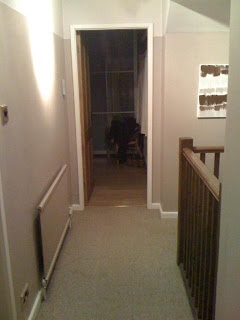
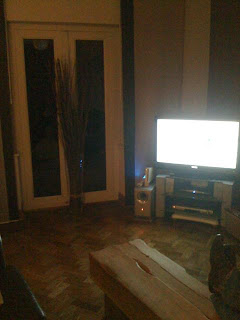



These sheets are used to show that we have
 permission for using the location in which we want to film. Also, it allows us assess whether it will be the best place for our shots, as well as looking at health and safety and the ability for us to shoot here.
permission for using the location in which we want to film. Also, it allows us assess whether it will be the best place for our shots, as well as looking at health and safety and the ability for us to shoot here.Make Up Design Sheet
Tuesday, 9 November 2010
Written Storyboard
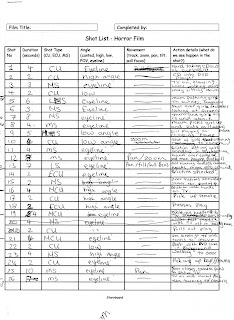
Home Video Script




Test Shot
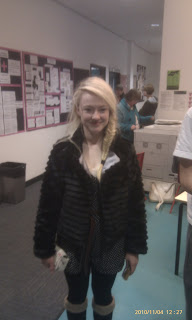 This is our main character (Zara) dressed as she would be during the graveyard scene. She is dressed in black to show her grief as she is visiting her mothers grave.
This is our main character (Zara) dressed as she would be during the graveyard scene. She is dressed in black to show her grief as she is visiting her mothers grave.Friday, 5 November 2010
Health and Safety Sheet
Textual Analysis Sheet 2
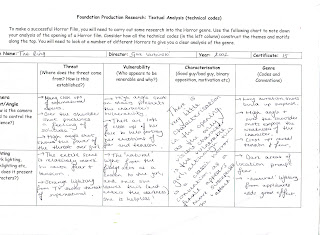
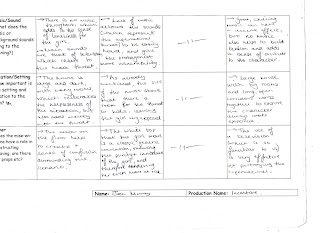
Saturday, 23 October 2010
Drawn Story Board (1min)
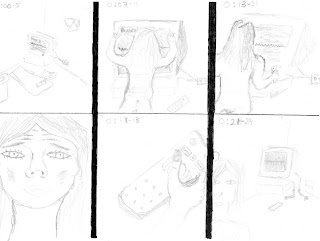
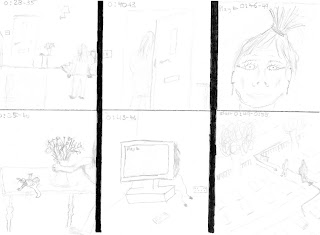
Friday, 22 October 2010
Film User Ratings
 Another exercise which allows us to consider our
Another exercise which allows us to consider our The second graph shows the user ratings data for 'The Grudge', starring Sarah Michelle-Gellar. Similarly to 'The Ring', it is the male audience that have largely viewed this page, and the males aged 18-29 are once again the largest sub-section. Furthermore, the males aged 30-44 (which had a big further for 'The Ring') have a large effect in this graph.
The second graph shows the user ratings data for 'The Grudge', starring Sarah Michelle-Gellar. Similarly to 'The Ring', it is the male audience that have largely viewed this page, and the males aged 18-29 are once again the largest sub-section. Furthermore, the males aged 30-44 (which had a big further for 'The Ring') have a large effect in this graph.  One of our favourite psychological horrors that we used as research was Steven Spielberg's 'Poltergeist'. As with the previous two, there is the common audience of males between the ages of 18-29 and 30-44. However, one slight difference is that this film appears much less popular with females than 'The Grudge', and this may be down to the protagonist; Sarah Michelle-Gellar plays the main character in 'The Grudge' whereas there are several protagonists in 'Poltergeist', and possibly less emphasis on young women. This supports our choice to place a teenage female as the main person in our film.
One of our favourite psychological horrors that we used as research was Steven Spielberg's 'Poltergeist'. As with the previous two, there is the common audience of males between the ages of 18-29 and 30-44. However, one slight difference is that this film appears much less popular with females than 'The Grudge', and this may be down to the protagonist; Sarah Michelle-Gellar plays the main character in 'The Grudge' whereas there are several protagonists in 'Poltergeist', and possibly less emphasis on young women. This supports our choice to place a teenage female as the main person in our film. 
Classification


Step Outline (13th October)
| Description of what is happening scene by scene | Number of shots in this section Average length of shot |
Titles at the bottom of the screen Ending with the Title of film at the end of the home video APPROX-1min | 3 shots – 3/4secs each approx 4/5 shots – 7-10 secs each approx |
Getting ready to go to mum’s grave Start of supernatural activity APPROX-45secs | 7 shots – 3-9 secs each approx |
Main character at the graveyard Long shot of her going to grave Including unknown hooded figure APPROX-1min
| 2 shots – 8 secs each approx 4 shots – 2-4 secs each approx 3 shots – 7-10 secs each approx |
Main character returns home Supernatural activity increases High angle shot from top of the stair case Hooded figure seen at scene 3 at the end of the garden APPROX-2min 15sec | 4 shots – 3-8 secs each approx 3/4 shots - 2-6 secs each approx 2 shots – 10-15 secs each approx 2/3 shots – 3 secs each approx |
Wednesday, 20 October 2010
Lighting Lesson Photos
 This first photo shows the use of just one light: the key light. It is focused on one side of the characters face, thus creating dark shadows both behind him and on the opposite side of his body and head.
This first photo shows the use of just one light: the key light. It is focused on one side of the characters face, thus creating dark shadows both behind him and on the opposite side of his body and head. This second image is again created through the use of solely one light, which in this case is the back light. The character stands straight in front of the light to create one large shadow. This technique may be useful in our horror film to create areas of darkness which may be able to move and therefore create tension.
This second image is again created through the use of solely one light, which in this case is the back light. The character stands straight in front of the light to create one large shadow. This technique may be useful in our horror film to create areas of darkness which may be able to move and therefore create tension. This image shows the use of a red gel, which is placed in front of the key light to alter the colour of the shot. It creates a rather evil, sadistic effect, and with the addition of a fill light, one side of the face is more lit than the other.
This image shows the use of a red gel, which is placed in front of the key light to alter the colour of the shot. It creates a rather evil, sadistic effect, and with the addition of a fill light, one side of the face is more lit than the other. This final image shows the use of a fill light (torch), which has been placed behind some paper so as to distribute the light more evenly, stopping the harshness which may come with just the torch. In this case it has created a half of light and a half of shadow, which may well come in useful with our horror.
This final image shows the use of a fill light (torch), which has been placed behind some paper so as to distribute the light more evenly, stopping the harshness which may come with just the torch. In this case it has created a half of light and a half of shadow, which may well come in useful with our horror. Lighting Lesson
Monday, 18 October 2010
Title Sequence Research
Evaluation of Previous IB Work


















